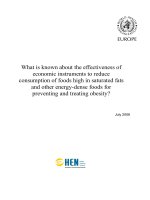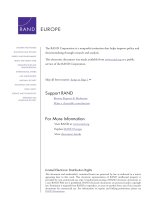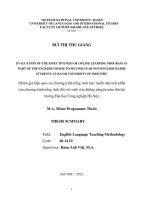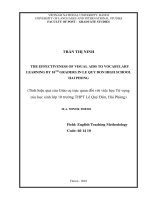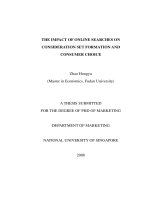measuring the effectiveness of online advertíing
Bạn đang xem bản rút gọn của tài liệu. Xem và tải ngay bản đầy đủ của tài liệu tại đây (4.53 MB, 78 trang )
www.pwc.fr
Measuring the
effectiveness
of online
advertising
Study conducted by PwC
for IAB France and the SRIMeasuring the
effectiveness of
online advertising
Study conducted by
PwC for IAB France
and the SRI
PwC | 63 rue de Villiers 92
200 | Neuilly-sur-Seine
Summary
Introduction 4
Key points of the study 6
Background 12
–New ways of using the internet help boost the development
of online advertising
13
–Formats and targeting techniques are evolving 13
–Monitoring the performance of online advertising
is becoming a key challenge
14
Seven key approaches to effectively measuring
online advertising 16
–Dening the objectives of online communications strategies 17
–Measuring the Web’s contribution to branding objectives 22
–Measuring the impact of online campaigns on ofine sales 34
–Measuring media mix effectiveness 41
–Analysing the impact of online advertising on browsing behaviour 45
–Assessing the impact of targeting on all aspects of the campaign 50
–Measuring the impact of advertising formats on conversion and branding 56
Conclusion: towards an effective measurement approach 68
Bibliography 70
Introduction
Over the past ve years, advertising
budgets allocated to internet media
have grown spectacularly. In 2010,
the internet will represent 16%
of total advertising expenditure
worldwide and this gure could
reach 21% in the next four years
1
.
This growth is signicantly fuelled
by search and “performance”
tools (afliate marketing, email,
comparison websites, etc.),
although display advertising
continues to represent a large
portion of online budgets (49%
in 2010 and 45% in 2014)
2
.
Two trends are driving this boom:
•
an increase in Web usage which
strengthens the internet’s role in
providing recommendations and
preparing consumers to make
purchases and recommendations
•
developments in targeted
advertising formats and
techniques which help shape
more communicative and
relevant online campaigns
Although the internet is by nature
a quantiable medium, online
strategies are not yet adequately
based on a suitable performance
measure. Advertisers realise that
measuring performance is an
important issue, but for the most part
they face difculties in implementing
appropriate methods and indicators.
This is rst of all put down to a lack
of resources, but other reasons often
alluded to are organisation, tools and
the need to strengthen expertise
3
.
This new environment has
prompted advertisers to consider
several fundamental questions:
•
Which media mix should be
used to achieve an optimum
communications strategy?
•
How can digital media be
most effectively combined
with other media?
•
How do online communications
inuence a brand’s image
and reputation?
•
How can the impact that
online advertising has on
bricks-and-mortar distribution
networks be measured?
•
Which targeted advertising formats
and techniques are best suited
to the marketing objectives?
Aside from traditional clickthrough
rates, the limitations of which
are outlined in this study, there
are several indicators available to
advertisers, including the web-based
gross rating point (GRP), return on
investment (ROI), media post-tests,
exposure time and the engagement
rate. However, it is important
to dene in which framework
and with which objectives these
resources should be used.
The purpose of this study is to
identify the different ways of
measuring the effectiveness of
online advertising. It is aimed
at online marketing and media
buying professionals and, more
generally, at all departments
involved in digital media.
Our study focuses on measuring the
performance of display advertising
and covers seven key approaches:
•
Dening an online
communications strategy
•
Measuring the Web’s contribution
to branding objectives
•
Measuring the impact of online
campaigns on ofine sales
•
Measuring media mix effectiveness
•
Analysing the impact of online
advertising on browsing behaviour
•
Assessing the impact of targeting
on all aspects of the campaign
•
Measuring the impact of
advertising formats on
campaign performance
For each of these topics, our aim
is to analyse market trends based
on benchmark studies conducted
by market research institutes,
advertising agencies and sales
agencies, companies specialised in
measuring advertising performance
and consultancy rms.
We interviewed several advertisers
from a variety of industries as well
as three media agencies in order to
understand their view of the key
issues at stake and identify together
the best resources for measuring the
effectiveness of online advertising.
We hope that this study will
provide you with useful insights
to help you plan for the future.
PwC
|
5
Key points of the study
New opportunities, new
measurement challenges
Today the internet is at the core of
communication and consumption
behaviour. For example, internet
users in the U.S. spend 58minutes
watching video or surng on
the web
4
. 78% of internet users
state that they consult a website
before buying a product
5
.
As social networks develop, the
Web has also become a place
where a brand’s reputation
and image is shaped.
Advertising formats are more
developed, videos more sophisticated
and targeting tools more focused.
Now that advertisers are better
equipped for communicating
on the Web, they are gradually
directing their budgets towards
online advertising. Measuring
online advertising performance is
therefore becoming critical for them.
For display advertising campaigns,
the clickthrough rate remains the
most widely used indicator, but
is not without its limitations. In
2009, only 16% of internet users
clicked on advertisements
6
. In
addition, this rate gives no indication
of the impact of a campaign on a
brand’s image or on the consumer’s
subsequent browsing or purchasing
behaviour. So there is now a real
need to nd other solutions
Starting point:
a clear online strategy
Developing the brand
experience, growing online
or ofine sales, generating
leads, reducing acquisition
costs an online campaign
can have many objectives.
It can have many resources too,
including brand websites, search
tools, rich media campaigns,
presence on community networks
and website sponsoring.
Which online resources achieve
the best performance in terms
of a campaign’s objectives? How
much of the budget should be
allocated to each resource? For
advertisers investing 10%-30% of
their budget in online advertising,
and up to 50% in some campaigns,
these questions are crucial
7
.
Faced with this realm of
possibilities, the advertisers
who were interviewed identied
two key imperatives:
•
Dening a clear and measurable
online strategy with indicators
tailored to each objective
•
Measuring the Web’s performance
together with that of other media,
in terms of coverage, impact on
the brand and additional sales
Measuring the impact of
campaigns on the brand
61% of American advertisers nd
that the internet meets branding
imperatives such as awareness,
recognition, brand loyalty and
purchase intent. Several studies
demonstrate the impact the Web has
on a brand. For example, an analysis
conducted on a campaign run by
a catering rm reveals that brand
identication improved by 10%
8
.
Similarly, a luxury goods campaign
achieved a rise of 9%. By studying
display advertising campaigns run
by four advertisers from different
industries, Médiamétrie NetRatings
revealed that the purchase intent
of internet users who were exposed
to these campaigns increased
by 11%. In a study of 73 display
advertising campaigns reaching
100,000 internet users, United
Internet Media found that the
internet enabled the rate of aided
brand awareness to jump by 26%
9
.
Post-test studies continue to be the
benchmark method for evaluating
the impact of campaigns on a brand.
In this respect, it is increasingly
common for advertisers to carry
out specic analyses on the Web.
Indicators other than the
clickthrough rate can however
help determine the impact online
advertising has on branding. By
measuring exposure, advertisers
are aware of the actual visibility
of a display advertisement and
the average time during which
internet users are exposed to the
advertisement. This indicator
will continue to develop in the
future with the standardisation
of measurement methods.
PwC
|
7
Key points of the study
8 | Study conducted by PwC for IAB France and the SRI | Measuring the effectiveness of online advertising
Key points of the study
Measuring interaction also provides
an initial analysis of the impact
a video or rich media campaign
has on a brand. Several studies
have revealed a close correlation
between interaction and impact on
a brand’s reputation and image.
Advertisers can also assess the
impact of their branding campaigns
by internet users’ engagement
on a website. This is achieved by
analysing every aspect of their
browsing behaviour, including
depth, duration and actions.
From our meetings with advertisers,
we discerned a strong tendency to
develop these online indicators,
which provide a responsive
interpretation of the impact
on their brands and can be
monitored over the long term.
Do online campaigns
generate ofine sales?
In 2009, 24% of French internet
users interviewed by IFOP
responded that they could
be enticed to buy a product
advertised online. The same
percentage of respondents
said that TV advertising could
inuence them in the same way
10
.
In 2010, eight out of ten internet
users interviewed by Médiamétrie
reported consulting a website
before purchasing a product
11
.
This trend is conrmed by
assessing the impact that online
advertising campaigns have on
ofine sales. After analysing the
purchasing behaviour of a panel of
185 million consumers, comScore
showed that exposure to display
advertising campaigns resulted in
a 10% increase in shop sales
12
.
The objective of online advertising
is therefore not just to boost web
trafc and online sales. It also
has real leverage to boost sales in
bricks-and-mortar distribution
channels. But how can this be
demonstrated and evaluated?
Post-tests assess the impact of
advertising campaigns on consumer
behaviour and purchase volume.
Econometric models can be used
to measure the impact of advertising
on the Web and other media on
sales over time, but they require a
relatively long observation period.
In general, advertisers often
use an empirical measurement
method by cross-checking sales
data against media campaign
strategies. Many advertisers feel
this method could be improved
as a number of organisational
and technical issues make the
indicators difcult to implement.
Finding the most
effective mix of the
Web and other media
Media use is becoming increasingly
interlinked. In 2009, 40% of
European consumers watched TV
at the same time as browsing on
the internet at least once a day
13
.
The Web is viewed as a means of
both extending coverage and
optimising performance with a
xed budget. A study carried out
by Nielsen for an alcoholic beverage
manufacturer revealed that by re-
allocating 10% of the TV advertising
budget to the Web, the advertiser
succeeded in increasing its audience
by 3.4% and boosting the campaign’s
total GRP (gross rating point - see
denition on page 30) by 20.7
points. Mixing media is an effective
means of branding, which in some
cases can enhance brand awareness
and loyalty by up to 20%
14
.
Key points of the study
Key points of the study
PwC
|
9
Key points of the study
10 | Study conducted by PwC for IAB France and the SRI | Measuring the effectiveness of online advertising
Key points of the study
Media agencies propose different
techniques for measuring the
impact of media mixes that show
the impact of a shift to more
frequent and repeated Web use.
These decision-making tools can
be complemented by conducting
post-tests on the contribution made
by different media to branding
objectives. In spite of this, comparing
the effectiveness of TV and online
data presents a real challenge to
advertisers, 70% of whom say they
would like to be able to compare
more easily the effectiveness of
online and TV advertising
15
.
What impact does
display advertising
have on the behaviour
of internet users?
Exposure to advertising has an
impact on the behaviour of internet
users on the brand website. A study
conducted in 2009 by the Online
Publishers Association reports that
the time spent by internet users on
websites is on average 50% higher
following exposure to a display
advertising campaign
16
. Advertising
generates activity on the website
which has to be measured on all
levels: depth, duration of visits,
purchases and registrations
generated. Tracking, whether it
be focused on websites or users, is
commonly viewed by advertisers
as a key means of measuring
and monitoring performance.
Online advertising exposure also
stimulates online searches. Display
advertising triggers a signicant
rise in the number of campaign-
related searches, demonstrating
the intrinsically complementary
nature of display advertising and
search. According to comScore,
the probability that consumers in
Europe perform a search on the
brand, or key words relating to the
brand, is multiplied by 2.3 after
exposure to an online advertising
campaign
17
. Advertisers should
identify and assess this impact,
so as not to undervalue display
advertising in relation to search.
Multi-exposure analysis can enable
advertisers to dene the right
level of message repetition and
the most effective combination
of online advertising resources.
What is the impact of
targeted advertising?
Behavioural targeting is expanding
rapidly. According to eMarketer,
it will grow annually by 23% over
the next ve years in the United
States
18
. Retargeting, in particular,
is advancing exponentially and is
generating up to 16 times higher
19
post-click conversion rates. Online
retailers closely monitor its impact
on conversion, but its impact on
brands is seldom measured by
brand-focused advertisers. In
the future, measuring the impact
of behavioural targeting will be
essential because real time online
auctions will promote its wider use.
Which are the most
effective advertising
formats?
It is estimated that video and
rich media will represent 63%
of the European market in 2014,
compared with 40% today
20
.
Even so, in certain cases a static
banner remains the most effective
way of conveying a message.
Advertisers should therefore
measure the impact of different
formats in order to choose the
ones best suited to their needs.
New methods are emerging for
measuring the impact of rich media.
As the clickthrough rate proves to be
an inadequate form of measurement,
the interaction rate and time are
becoming key. Measuring interaction
enables the impact a video or rich
media campaign has on a brand to
be analysed. It is especially relevant
for advertisers who do not aim
to increase web trafc or website
engagement. With the emergence
of these new formats, creativity
once again offers the means to stand
out from the crowd. Approaches
designed to pre-test the impact
of online creations may develop
further in the years ahead.
Key points of the study
Key points of the study
PwC
|
11
Five levels for effectively measuring online advertising
Browsing
Interaction
Actual exposure
Display
Number of impressions Mature, minimum indicator
Number of advertisements
“viewed”, exposure time,
display surface
Interaction rate/length
of interaction
Number of visits, time,
depth, recurrence
Committing interactions
(newsletter subscription,
catalogue requests, credit
simulations, quotes, etc.)
Indicators Level of maturity and trend in use
Mature and fundamental for
online retailers
Developing for brand-focused
advertisers
Developing, depending on advertisers
Often associated with purchases
through recommendations
Still not widely used for measuring
branding
Developing rapidly, in line with
growth in rich media and video
Often only partially exploited
On the rise, being
trialled by many
advertisers
Not yet fully available
Background
New ways of using the
internet help boost
the development of
online advertising
Simultaneous use of the
internet and TV is becoming
more widespread
The emergence of the internet
has not replaced the use of other
media, particularly TV. Rather
than competing, these two media
complement each other. The
internet acts as an extension to the
TV experience. As demonstrated
by a Microsoft Advertising study,
78% of internet users believe that
watching videos online complements
their TV use. Internet users look
out for specic, unusual and
previously unavailable content
21
.
This simultaneity in media
consumption enables the brand
experience to be prolonged
through online media and
encourages advertisers to mix
the Web with other media.
The internet asserts
itself as an essential
tool for inuencing and
preparing purchases
Today, the internet is at the heart
of purchase processes. The 2010
FEVAD-Médiamétrie barometer
shows that 78% of internet users
consulted a website before buying
a product
22
. The Web is becoming
a highly inuential medium, in
the same way as TV. Internet users
know how to make the most of the
numerous resources available to
them, including retail websites,
consumer reviews, comparison
websites and forums. This trend has
been strengthened by the crisis, the
slowdown in household spending
23
and the development of “hunter”
or opportunistic behaviour.
This development underpins the
importance for advertisers to
conduct as detailed an analysis
as possible of the multi-channel
purchasing path used by buyers. It
is vital to understand the impact
advertising has on ofine sales
and in particular its ability to
foster consumer engagement and
inuence consumers’ decisions.
Social networking
offers advertisers a new
platform for expression
Internet users spend a tremendous
amount of time using exchange
and communication services on the
Web. According to Médiamétrie/
NetRatings, internet users spend
on average 3hours 40minutes per
month on instant messaging, 4hours
8minutes on community networks,
2hours40 minutes on emailing
and 1hour15minutes on online
auctions or classied ad websites
24
.
This new use of media, including
community and social networking
sites, generates additional
advertising space which provides
advertisers with remarkable
targeting opportunities (through
a greater targeting capacity
and increased exposure times).
Nevertheless, advertisers must assess
the relevance and effectiveness of
these new spaces in relation to their
own communication objectives.
“Advertisers are aware
of the large number of
resources available to
them for measuring the
effectiveness of online
advertising. It is up to each
one of them to select the
most useful indicators for
their interactive strategy and
develop an online culture
within their environment.”
Thierry Limousin
Digital Director, Samsung
Formats and targeting
techniques are evolving
The increased number of
advertising formats and
spaces requires the actual
visibility of advertisements
to be measured
Continuous innovation and
greater choice in formats mean
that analysing the actual impact
of different advertisements is a
complicated procedure. This impact
depends on at least two factors: the
screen space, or proportion of the
screen used by the banner; and the
duration of the advertisement.
With webpages becoming more
elaborate, it is necessary to
measure the difference between
the impressions delivered and
the impressions seen by the user.
In fact, only the latter are likely
to have an impact on the user.
Based on these ideas, resources are
emerging for measuring advertising
exposure which help improve
measurements of the impact of
advertising in terms of branding.
PwC
|
13
Background
14 | Study conducted by PwC for IAB France and the SRI | Measuring the effectiveness of online advertising
Background
Rich media and video
advertising offer new
brand experiences
Rich media formats have advanced
considerably over the past ve years.
This progression heightens the
communicative potential of online
advertising. Links to a brand website
are no longer the be-all and end-all
of developing a brand experience.
The clickthrough rate no
longer provides an adequate
measure of the impact of these
advertisements. Indicators therefore
need to be put in place in order
to gauge the interaction with
advertisements. It is also necessary
to analyse the impact these new
formats have on reputation,
recognition and brand loyalty.
These enriched formats bring
the creative dimension of online
advertising to the fore. Measuring
the effectiveness of creative
approaches and the ability to adapt
is now a critical performance driver.
Developments in behavioural
targeting increase the
effectiveness of campaigns
Behavioural targeting has become
far more widespread these past
few years and is used in advertising
campaigns to reach out to the
right audience. By examining the
browsing behaviour of internet
users, proles can be established
for which display advertisements
can then be designed in accordance
with the internet users’ interests
or purchasing habits. For years,
media planners have been
searching for useful targeting
methods and have often had to
make do with information on
gender, age and socio-professional
groups. Behavioural targeting now
provides an answer to their needs
and often generates signicantly
higher conversion rates. It can also
be used in branding to draw the
consumers’ attention to a product
while they are shopping and tends
to have positive results in terms of
brand recognition and opinion.
Accordingly, behavioural targeting
is perceived as a means of bolstering
the effectiveness of online
advertising in the future, although
its impact has to be measured.
Monitoring the
performance of online
advertising is becoming
a key challenge
Advertisers see measuring
the effectiveness of
their campaigns as a key
challenge in their interactive
communications strategy
The internet is reputed to be
a quantiable medium but
advertisers are still dissatised
with the tools available to them
for evaluating its performance.
Faced with an overwhelming
amount of generated data, they
express a need for transparent
and comparable information.
The majority of advertisers
with whom we met conrmed
that measuring effectiveness is
instrumental to their online strategy.
Some advertisers wish to further
broaden their measurement tools,
for example by analysing web trafc
or assessing engagement more
systematically. Others highlight
the need for a better handling of
available data. They also insist on
the need to converge Web data with
data from other communication
sources in order to enhance
multi-channel monitoring.
Background
Background
PwC
|
15
Numerous metrics
are available, but the
clickthrough rate is still the
most widely-used indicator
A study conducted in March
2010 by eMarketer
25
reveals that
60% of respondents rely on the
clickthrough rate to measure the
effectiveness of their interactive
marketing campaigns (Figure 1).
This indicator is measured much
more extensively than other metrics
such as the amount of incremental
sales generated, the campaign
ROI, the brand’s reputation and
the engagement on the Web.
The tendency to use this indicator
can be explained by its user-
friendliness and by the difculties
experienced by some advertisers
in implementing more suitable
or transversal indicators.
The clickthrough rate
underestimates the
actual impact that display
advertising has on the brand
A study carried out by comScore in
2009 indicates that the number of
“clickers” is declining progressively.
The number of internet users
clicking on advertisements decreased
by 50% between 2007 and 2009
and in 2009 only 16% of internet
users clicked on advertisements.
Moreover, a small portion of internet
users accounts for almost all clicks
on online advertisements (8% of
users produce 85% of clicks). The
proles of those internet users that
do click on advertisements are also
quite specic (young people between
the ages of 25-44 with income of
less than USD 40,000 per year)
and do not always correspond to
the advertisers’ target audience
26
.
This study also outlines the
numerous effects brought about
by display advertising which are
not taken into account by the
clickthrough rate. For example,
a signicant portion of internet
users return to the website several
days after being exposed to the
advertisement. It also appears
that prior exposure to display
advertising campaigns has a positive
impact on search behaviour.
Perhaps the most limiting factor of
the clickthrough rate is that it does
not provide any information on the
kind of impact that exposure to an
advertisement gives rise to, whether
this is in terms of awareness, recall,
engagement or purchase intent.
Customised measurement tools
are therefore required in order
to effectively monitor online
advertising: we have identied seven
key approaches for this purpose.
Figure 1 – Indicators used by advertisers in the USA to measure the performance of
their online marketing campaigns
60%
49%
46%
40%
38%
32%
27%
22%
17%
Clickthrough rate
Lead generation
Response rate
Incremental sales
Return on investment (ROI)
Brand awareness or reputation
Requests for information
Engagement with Web content
Media impressions
Seven key approaches
to effectively measuring
online advertising
Dening the objectives of
online communications
strategies
The online strategy is
the convergence point
of media buying and
marketing imperatives
The advertisers we interviewed
allocated 15%-30% of their
total advertising budgets to
online advertising. Some online
advertisements even represented
more than 50% of the total campaign
budget. Despite a moderate increase
in online expenditure in 2008 and
2009 and, in particular, a tight rein
on display advertising expenditure,
all of these advertisers expect to
invest even more heavily in online
advertising over the coming years.
Advances in Web use now enable
advertisers to take advantage
of a wide range of online tools
that go beyond the traditional
trade-off between search and
display in order to develop their
online communications:
•
Brand websites and
co-branded websites
•
Resources for measuring customer
prospects and lead generation
•
Presence on community networks
•
Rich media campaigns
•
Content sponsoring, brand content
As a result of these two trends
towards greater use of i) online
advertising and ii) newly developed
online advertising tools, advertisers
are asking themselves several
questions: How much of the
advertising budget should be
allocated to the internet? How
much should be allocated to
each form of advertising within
the online strategy? Which
online tools are best able to meet
my campaign objectives?
The answer to these questions
lies in devising and measuring
an online strategy, taking
into account two factors:
•
A marketing factor which aims to
assess the effectiveness of online
methods with regard to campaign
objectives in terms of the impact
on the brand (awareness, recall,
brand preference, etc.) and/
or performance (online and
ofine sales growth, generation
of opportunities, etc.)
•
A media buying factor which aims
to manage communication budgets
by assessing the Web’s potential
to contribute effectively to the
media strategy (target coverage,
message repetition, media mix)
From an organisational point of
view, we realised that measuring
the performance of online
advertising represents a challenge
for both Marketing and Media
departments. There are several
organisational models which take
into account these two factors.
“Increases in online
budgets must be based on
appropriate performance
measures, in order to
justify and optimise
digital investments.”
Matthieu Couturier
Media Director, Leclerc
“We have a wide range of
online resources available
(search, display, social
networks, brand websites,
media partnerships, etc.)
which we use in different
ways depending on the
objectives of our brand
campaigns. For each one,
we use specic measurement
indicators and assess
the nal contribution
made by online resources
to the effectiveness of
our brand strategy.”
Julien Guiraud
Digital Marketing, Manager, Coca-Cola
“The Web offers specic
indicators which are very
instructive. However, it is
essential to converge Web
performance measures
with those of other
advertising channels in
order to develop a coherent
strategy across all media.”
Frédéric Guichard
Marketing Director,
Danone Still Water division
PwC
|
17
Seven key approaches to effectively measuring online advertising
18 | Study conducted by PwC for IAB France and the SRI | Measuring the effectiveness of online advertising
Seven key approaches to effectively measuring online advertising
To be effective, the internet
must be embedded in the
overall marketing strategy
Many online indicators are available
to digital media managers. Such
an array of indicators allows for
specic, and often more responsive,
measurements to be taken of
internet advertising. But a wide
variety of indicators does not always
provide a suitable measurement
of the effectiveness of a marketing
strategy. Some advertisers run
the risk of “infobesity”. Rather
than measuring data using a
broad spectrum of indicators, it
is more important for advertisers
to synthesise and compare data
between different media (the
Web, TV, radio, press, etc.). Most
advertisers emphasise the need for
integrated measuring and tracking
systems, in three areas in particular:
•
Understanding media
coverage and repetition
•
Analysing the impact of
campaigns on the brand
•
Measuring the impact on sales
More sophisticated advertisers
design strategies which incorporate
all types of media. These are
then applied to tracking systems
managed by Web experts. The
online strategy is not considered
in isolation, but in terms of
its contribution to the overall
marketing and sales objectives.
Online tools are becoming
increasingly specic and
their performance must be
evaluated in each campaign
The ability to create online tools
for different campaigns provides
advertisers with an edge in what is a
highly competitive market. Bespoke
tools such as brand websites, one-
off initiatives, brand content and
social network campaigns should
be individually measured in terms
of their visibility, engagement or
impact on the brand’s image.
It is equally important to ensure
clear visibility in monitoring online
campaigns by using comparable
indicators and analyses which are
regularly shared. To assess online
performance over the long term and
shed a strictly opportunistic and
short-term view, particular emphasis
must be placed on preparing annual
performance reports. Due to rapid
advancements in this form of media,
the ability to learn is crucial.
In view of the different
possible objectives, suitable
indicators need to be
dened and implemented
We provide below a rough outline
of the different objectives an online
advertising campaign may have:
•
Branding: the purpose of
branding campaigns is to bolster
different components of the brand,
such as awareness, image or
purchase intent. These campaigns
generally form part of a wider
media strategy and it is their
combined impact with other
media which is often measured.
•
Developing customer engagement
also falls within the framework of
branding and aims to broaden the
online brand experience, but with
the specic objective of interacting
directly with the internet user.
•
Growing ofine sales continues
to represent the ultimate objective
of a brand campaign, with
the exception of institutional
campaigns. This objective can
be more specically sought
or measured for certain
campaigns and as such evaluated
with greater precision.
•
Growing online sales: these
campaigns specically aim to
generate sales on the brand
website or on partner networks.
Such campaigns can also
simultaneously pursue conversion
and branding objectives.
•
Generating leads is based on a
performance-oriented approach,
but does not aim to increase
online purchases. The objective
is to get to know the internet
user using interactive resources
for classication purposes, such
as games and questionnaires.
•
Boosting coverage and message
repetition: with rising penetration
rates, the Web is quickly becoming
a mass medium which allows
for greater message exposure.
One of the objectives of a Web
campaign can be to strengthen the
message coverage and repetition
achieved through other media.
•
Reducing acquisition costs can
be another ambition of an online
campaign. This is fundamental for
performance-focused advertisers.
These different objectives are not
incompatible and the same campaign
can, for example, aim both to
develop the impact of the brand and
generate an increase in shop sales.
For each of these objectives, different
indicators can be used. The following
page presents an initial but by no
means exhaustive list, which gives
an idea of the range of measurement
tools available to advertisers. The
same indicator can often be suitable
for measuring different objectives.
Seven key approaches to effectively measuring online advertising
Seven key approaches to effectively measuring online advertising
PwC
|
19
“Effectiveness is measured
campaign by campaign,
on a weekly, even daily,
basis. But long-term
performance reports
covering all campaigns
must also be prepared in
order to unlock synergies
between online resources
and devise strategies for
the following year.”
Irène Labus
Digital Analytics Director, Havas Digital
Seven key approaches to effectively measuring online advertising
20 | Study conducted by PwC for IAB France and the SRI | Measuring the effectiveness of online advertising
Seven key approaches to effectively measuring online advertising
Nine categories of indicators for measuring online performance
Display
•number of impressions
•number of “visible” advertisements
•number of advertisements viewed
•exposure timew
Conversion
•clickthrough rate
•conversion rate
•post-view conversion rate
•post-click conversion rate
Traffic
•number of visits generated
•number of pages viewed
•length of visit
•abandon rate
Interaction
•interaction rate
•interaction time
•expansion rate
•rate of videos viewed
•rate of videos viewed in full
•video viewing time
•activity on social networks
Subscription
•number of subscriptions
•(requests for information,
games, newsletters, etc.)
•subscription rate
•recommendation rate
•(social networks, viral
e-marketing campaigns)
Media
•gross rating point (GRP)
•memorised coverage
•coverage rate
•message repetition rate
Distribution
•additional sales generated
•revenue generated
•lead conversion rate
•impact on the frequency and
volume of purchases
•retail outlet trafc generated by the Web
ROI
•acquisition cost (ofine vs. online)
•ROI (revenue generated/
advertising expenditure)
Post-tests
•impact on awareness
•impact on advertisement recall
•impact on brand image
•impact on purchase intentions
•impact on recommendations
Seven key approaches to effectively measuring online advertising
Seven key approaches to effectively measuring online advertising
PwC
|
21
Which indicators should be paired with which objectives?
INDICATORS
Online
advertising
campaign
objectives
Display Conversion Traffic Interaction
Sub-
scription
Coverage
Offline
sales
ROI Post-tests
Contributing
to the brand’s
development
Developing
engagement
Growing
offline sales
Growing
online sales
Generating
leads and
classifying
potential
customers
Boosting
coverage
and
repetition
Reducing
customer
acquisition
costs
Seven key approaches to effectively measuring online advertising
22 | Study conducted by PwC for IAB France and the SRI | Measuring the effectiveness of online advertising
Seven key approaches to effectively measuring online advertising
“For several years now we
have considered the Web
to be a key medium for
developing our brands. Our
online investments increase
annually by almost 15%.
One of our main focuses is
establishing strong long-
term relationships with
partner websites such as
MSN for the Coca-Cola zero
Gaming Zone, Skyrock for
the Kohop mutual aid site,
and Yahoo! for Coca-Cola
light. It is therefore crucial
that we measure internet
users’ exposure to these
campaigns and the impact
this has on the image they
have of our brands.”
Julien Guiraud
Digital Marketing Director, Coca-Cola
Measuring the Web’s
contribution to
branding objectives
Advertisers value the Web
to an increasing extent as
an effective medium for
developing their brands
In view of the growing number
of advertising slots, numerous
performance-based offers have
been developed by advertising
sales agencies. These models
comprise “pay per click” or “pay per
action” (purchases, appointments,
registrations, etc.) advertising,
and prove very popular with
advertisers whose objectives
are focused on conversion.
Nevertheless, advertisers do not only
regard online advertising as a means
of generating trafc or purchases.
The advertisers we interviewed
conrmed that ever greater
attention is placed on the impact
the Web has on brand awareness
and image. This trend is especially
true of certain industries such as
luxury goods or consumer goods,
which incorporate the Web more
widely in their media strategies.
Branding tools are also becoming
increasingly varied (brand websites,
rich media campaigns, presence on
social networks, content sponsoring,
etc.). Measuring the effectiveness of
branding tools therefore represents
a key priority for advertisers.
As demonstrated in a study by Bain
& Company, although performance
investments represented 59%
27
of the market in the United States
in 2009, 61%
28
of these same
advertisers judged the internet to
be well-suited to addressing their
branding needs (Figure 2).
The all-inclusive aspect
of this assessment should
not conceal the individual
objectives of advertisers,
which can be classied
in three categories:
•
Online retailers whose
communication budgets
correspond to objectives
of increasing web trafc
and online sales
•
Advertisers who view the Web
purely as a means of promoting
the brand and whose main
objective does not necessarily
focus on acquiring customers
or increasing sales (for
example, in the luxury goods or
consumer goods industries)
•
Advertisers who combine
branding with online sales
and customer acquisition (for
example, in the automotive
and telecoms industries)
Measuring brand effectiveness
is becoming increasingly
important for these last two
categories as they refocus their
budgets on digital media.
Seven key approaches to effectively measuring online advertising
Seven key approaches to effectively measuring online advertising
PwC
|
23
Figure 2 – Breakdown of advertising expenditure and advertisers’ marketing objectives – USA, 2009
Creating awareness
59 %
perfomance
61 %
branding
Generating
familiarity
Promoting
consideration
Driving
trafc/Purchase
intent
Promoting loyaltyHybride
Performance
CPM
37 %
59 %
4 %
26 %
15 %
20 %
32 %
6 %
Advertising expenditure - 2009 Marketing objectives for which
advertisers believe the internet to be
most suitable - 2009

